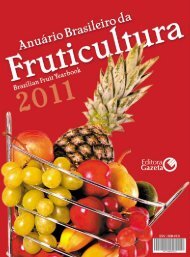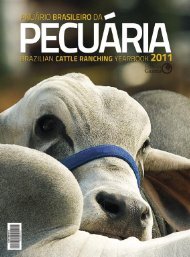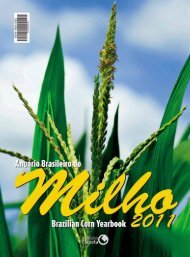tradicionalmenteinovador - Brazil Buyers & Sellers
tradicionalmenteinovador - Brazil Buyers & Sellers
tradicionalmenteinovador - Brazil Buyers & Sellers
You also want an ePaper? Increase the reach of your titles
YUMPU automatically turns print PDFs into web optimized ePapers that Google loves.
million tons, valued at R$ 16 billion.<br />
With regard to the informative field,<br />
two years ago the program carried out a<br />
diagnosis on the sector, with surveys including<br />
the year 2007, but is supposed to<br />
be updated in 2011 containing data up<br />
to 2010, to serve as basis for actions and<br />
support moves. Within this context, the<br />
manager points out that petitions are to<br />
be included in the 2012-2015 Pluriannual<br />
Plan of the federal government, where the<br />
predominant petition consists in the allocation<br />
of resources for the cold chain, expanding<br />
the refrigerated environments in<br />
the sales areas so as to reduce losses and<br />
supply high quality products. Support to<br />
producer organizations sales options, like<br />
“Producer Tents or Pavilions”, and transport<br />
logistics, with appropriate vehicles.<br />
>> EFFICIENCY “All ceasas should<br />
be efficient centers for the consolidation<br />
and distribution of products, as well as<br />
sources of information, development, capacity<br />
building, quality control, support<br />
to family farmers, small retail outlets and<br />
small food services, eliminating or reducing<br />
the current distortions that benefit<br />
the commercial growers, whilst promoting<br />
fair and loyal competition.” This is the<br />
idea expressed by Anita de Souza, Head of<br />
the Horticulture Quality Control Center of<br />
the Trade Centers Company and General<br />
Warehouses of São Paulo (Ceagesp), the<br />
biggest horticulture trading Center in the<br />
Country.<br />
Anita complements that the strengthening<br />
of the small-scale producers depends<br />
on the existence of a logistic delivery<br />
Center, efficient consolidation and<br />
distribution, with fair and transparent<br />
trading rules, a decision making system<br />
that lends support to the productive chain<br />
and a quality control system that attests<br />
to the safety and quality of the food. She<br />
refers to the beginning of the revitalization<br />
process under the coordination of<br />
the Prohort and, with regard to Ceagesp,<br />
she reveals that the company is making<br />
a huge investment in the infrastructure<br />
of the Ceasa in São Paulo, jointly with the<br />
wholesalers at the Market Modernization<br />
Fund.<br />
As to her specific quality control area,<br />
Anita recalls that work started in 1997,<br />
when the São Paulo Program for the Improvement<br />
of the Horticultural Trading<br />
Patterns started operating, a program<br />
that has been transformed into the <strong>Brazil</strong>ian<br />
Program on Horticulture Modernization.<br />
She mentions standards developed<br />
for grading fresh fruit and vegetables,<br />
which are responsible for more than 80%<br />
of the total, and capacity building oriented<br />
works, as well as the development<br />
of specific tools for every production and<br />
sales agent.<br />
Among other projects underway, she<br />
underlines the Ceagesp Producer Tent,<br />
which lends support to organized groups<br />
focused on improving competitiveness<br />
and building a brand; the Hortiescolha<br />
Program, geared toward food services;<br />
and Escola do Sabor (School of Taste),<br />
which, through amusing and attractive<br />
activities, introduces fruit and vegetables<br />
in the school meals and brings children in<br />
contact with agriculture.





